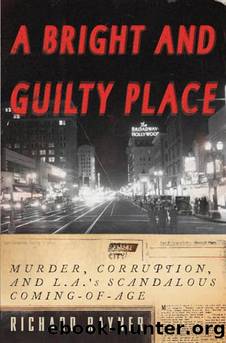A Bright and Guilty Place: Murder, Corruption, and L.A.'s Scandalous Coming of Age by Richard Rayner

Author:Richard Rayner [Rayner, Richard]
Language: eng
Format: epub
Tags: History, United States, General, 20th Century, True Crime
ISBN: 9780385530118
Google: nZVafdZDTUEC
Amazon: B002D9ZLJG
Publisher: Anchor
Published: 2009-06-22T16:00:00+00:00
18
Red Hot Bow
Buron Fitts failed in his gubernatorial run, but his strong showing in Southern California destroyed the chances of the incumbent C. C. Young, instead gifting the Republican nomination and the governorship to Mayor Sunny James Rolph, Jr., of San Francisco. L.A. had shown its increased electoral muscle in a statewide contest, and Fitts was already starting to look like a political fixture. He had his detractors. âFitts is an incurable exhibitionist; utterly lacking the legal acumen, ethical conformity and mental balance essential in a competent prosecutor,â wrote local newspaperman Guy Finney. âHe is constantly on the hunt for sensations in which he can pose as the hero; thinks of himself as a legal DâArtagnan. He is theatrically intemperate.â
Guy Finney was a hater of Fitts and had an axe to grind, though he was right that Fitts liked publicity and had quickly learned its value. Hollywood, a bottomless well of high-profile crime and scandal, was useful in this regard but had to be handled carefully. No master in court, Fitts nonetheless led the prosecution of theater-chain owner Alexander Pantages, accused of raping Eunice Pringle, a lithe and lovely seventeen-year-old high-school dropout. It was a great show, generating weeks of headlines; the young Jerry Giesler, having already bested Dave Clark, furthered his reputation by securing Pantagesâs acquittal on appeal. Buron Fitts was once more displeased, but generally he knew where his bread was buttered. He tended to side with, and not against, men like Pantages, the new Medicis of L.A.
âTo put it bluntly, the studios owned Buron Fitts,â wrote Budd Schulberg in his autobiography. Schulberg, author of the legendary Hollywood satire What Makes Sammy Run?, came of age in L.A. in the 1920s, growing up a âHollywood prince,â as he put it. He was the son of B. P. Schulberg, one of the early moguls and by 1930 head of production at Paramount. âThis was in the postâDesmond Taylor and Arbuckle days, when scandals that might have destroyed the reputations of valuable movie stars could be hushed up by the hear-no-evil-see-no-evil approach of the D.A.âs office,â Budd Schulberg wrote. âThis was Cover-up, Hollywood style, in the days when the film capital was a self-sufficient oligarchy, sunny and benevolent on the surface but hard and vindictive at the core.â
In the late summer of 1930, B. P. Schulberg called Fitts about his biggest star, Clara Bow. While visiting her boyfriend at Lake Tahoe, Bow played blackjack with what she was told were fifty-cent chips. It was a shakedown, and those fifty-cent chips actually turned out to be worth $100 apiece. To cover the debt, Bow wrote a $20,000 check she later cancelled. Within days two tough customers came to her Beverly Hills home on North Bedford Drive, demanding the money in terms that came straight from a Warner Bros. gangster story. âEither you make that check good tomorrow or youâll get acid all over your pretty puss. Instead of the It Girl, youâll be the Ainât Girl,â one of them said. Jimmy Cagney couldnât have put it better.
Download
This site does not store any files on its server. We only index and link to content provided by other sites. Please contact the content providers to delete copyright contents if any and email us, we'll remove relevant links or contents immediately.
Blood and Oil by Bradley Hope(1531)
Wandering in Strange Lands by Morgan Jerkins(1374)
Ambition and Desire: The Dangerous Life of Josephine Bonaparte by Kate Williams(1346)
Daniel Holmes: A Memoir From Malta's Prison: From a cage, on a rock, in a puddle... by Daniel Holmes(1295)
It Was All a Lie by Stuart Stevens;(1265)
Twelve Caesars by Mary Beard(1258)
The First Conspiracy by Brad Meltzer & Josh Mensch(1140)
What Really Happened: The Death of Hitler by Robert J. Hutchinson(1131)
London in the Twentieth Century by Jerry White(1114)
Time of the Magicians by Wolfram Eilenberger(1089)
The Japanese by Christopher Harding(1086)
Twilight of the Gods by Ian W. Toll(1085)
Cleopatra by Alberto Angela(1063)
A Woman by Sibilla Aleramo(1054)
Lenin: A Biography by Robert Service(1046)
The Devil You Know by Charles M. Blow(987)
Reading for Life by Philip Davis(973)
The Life of William Faulkner by Carl Rollyson(925)
1965--The Most Revolutionary Year in Music by Andrew Grant Jackson(924)
